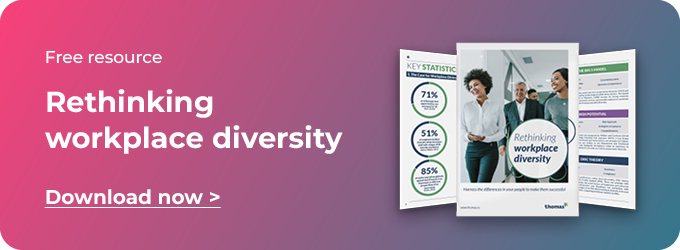Over the last few years businesses and individuals have started to understand more when it comes to the terms ‘diversity’ and ‘inclusion’. At its core, a more diverse and inclusive workforce can garner incredible results, but we are still finding that many don’t understand what a practical diversity and inclusion strategy can look like.
Whether it is understanding what diversity means, or having a better understanding of inclusion, a business that isn’t prepared in these areas will discover over time that they are missing key opportunities, and even start to suffer when it comes to expanding their business horizons.
In this guide, we are going to address these concerns, and explain why all organisations must consider creating a diversity and inclusion strategy as part of their core business plan.
We will look at what must be included as part of the diversity and inclusion strategy, the 10 things you must consider, and how our assessment tools can help you with a diversity and inclusion plan.
What is diversity?
Diversity in the workplace is understanding, accepting and valuing differences among a group of people who are from different races, ethnicities, genders, ages, religions, disabilities, social economic backgrounds and sexual orientations. This can also be taken further to include differences between education, personalities, skill sets, experiences, and knowledge bases.
There are different ways in which diversity can be understood and in turn form part of the corporate culture that identifies with a diversity plan. For example, a study in 2019 by Deloitte discovered that Millennials view diversity differently from Gen X in terms of both what it can mean, and how it should be used in business.
Practically, millennials view diversity as the combination of people from different backgrounds, ethnicities and experiences within a group, and believe that this should be used as an advantage to drive innovation within an organization. Gen X and Boomers on the other hand, believe that rather than focusing on innovation, diversity should entail greater equality and fairness regardless of demographics.
What is inclusion?
Inclusion in the workplace is about how supportive, collaborative and respectful a work environment can be. The idea is that by having a workplace that takes into account all of these considerations, you will develop greater participation between employees at every level.
Inclusion should be viewed as the ability to create a fairer workplace which removes barriers, discrimination and intolerance. Done correctly, it gives employees a feeling of being supported and included in key decisions.
A great example of inclusion is IBM’s initiative decided to let staff take over social media on specific days, showcasing different voices, ideas and people in the corporate media, and opening it up to to new ideas at the same time. Whether it was taking photos and posting them to live events, this way of bringing people together has been an important milestone in B2B social marketing.

What is a diversity and inclusion strategy?
A diversity and inclusion strategy is designed to increase not only the number of people with different backgrounds, ethnicities, genders, ages, religions and disabilities, but also to create a framework in which organisational structures cultivate a supportive, collaborative and respectful environment, that gives a voice to as many people within the business for the better.
Widely recognised as a key business strategy among the next generation of workers, a diversity and inclusion strategy is about not only giving fair and equal opportunities to different people, but also tapping into the new skills, ideas and visions this can bring to a team. For instance, it may be that there are gaps in the market for products and services because of a lack of representation within companies of team members from different communities who have experienced certain challenges.
Diverse teams have been shown to be more innovative and creative in solving problems, creating new ways of doing things and even building business success. Any strategy that can take hold of these ideas and realise them company-wide is going to benefit moving forward.
10 things to consider in your diversity and inclusion strategy
If you or your organisation are building a diversity and inclusion strategy within the operational side of the business, you must also take into account certain non-negotiable elements.
However, a diversity and inclusion strategy need not be inflexible either. Importantly it must be designed to provide opportunities and benefits so that team members are incentivised to participate, rendering even wider benefits.
What should you consider when creating a diversity and inclusion strategy? Here are some ideas:
1. A sense of belonging
This is a psychological need for everyone. For individuals to feel part of a special mission (in this case, company success), they must feel that they can open themselves up to provide insights and ideas without fear of feeling excluded from their peers or team.
Focus on creating an atmosphere that allows people to share ideas, problems and solutions openly. Take the time to understand each individual as a person and how they work best. Diversity and inclusion can ultimately come to reinforce each other synergistically.
2. Fair treatment
We all want to be treated fairly. But in an organisation, creating a transparent method of performance review assessments is essential.
Put simply, fair treatment is about how we treat others, and are treated ourselves. About 50% of all diversity and inclusion strategies don’t mention fairness, but this principle is widely regarded as a key to success.
3. Diversity education and training
Training your teams in cultural differences as well as inclusion is essential. By understanding differences and creating a space that is designed to be more inclusive of these differences, you build the foundations of a more inclusive working environment.
This doesn’t have to be ‘sheep dip’ training (although there can be a role for this) rather the learning can be embedded through a variety of means and resources, including D&I talks, short workshops and generally creating a safe environment for related conversations to be had.
4. Conflict resolution processes
Foster a more collaborative environment by opening up communications across the team to find solutions and new possibilities. You want to think about creating a space where you can have an open discussion of all issues and concerns, exploration of alternative solutions, and honesty and commitment from all the parties to ensure that the conflict is resolved.

5. Psychometric testing in recruitment / development
Using specific psychometric tests, you can better understand the different work and communication styles within your team. You could identify who is less likely to be open to change, how they typically manage conflict, and how they work best. These tests lay the groundwork for meaningful personal development and provide an objective basis for performance reviews.
By providing psychometric insights for your team, you can instil an awareness of the psychological factors that can interrupt efficiency and success at work. This awareness can transform culture from the bottom up, rather than placing the onus solely on the senior figures in a team to do so.
6. Build an empathetic leadership style
Many think that you can’t learn how to be empathetic, but this is not entirely true. There are many tools that you can use to develop empathy, which is an essential skill in developing and implementing your diversity and inclusion strategy. Leaders need to empathise with those who have felt isolated, alone, and discriminated against - and then take those feelings and experiences seriously when creating a new story for everyone involved. Empathy is also a critical starting point for opening up communications.
7. Focus on making it a company-wide experience
A solely ‘top down’ diversity and inclusion strategy, risks excluding others and their experiences. It is therefore important that you ensure the whole company is engaged with what you’re changing. Bring people into the conversation so that diverse needs can be met. This could involve dedicated training sessions that provide a better understanding of why diversity is important. If you want to enact lasting change. make sure everyone knows why.
8. Don’t focus on quotas
When it comes to recruitment, don’t just rely on quotas. Recruitment is a holistic process that also includes onboarding, training, team-building and selecting the right people for the culture you want to create. Support your D&I strategy with the best tools available to you to make it a success or not.
9. Think long term, not one off
Inclusion and diversity training cannot be a ‘one off’ event. It needs to be a continuous activity driven at all levels of the organisation to maintain an awareness of diversity and create an opening for discussion and collaborative problem-solving. When building culture in a workplace, it is important to think about embedding enduring change rather than purely tactical actions, such as tokenism.
10. Focus on innovation and creativity
One of the benefits of a diverse and inclusive team is that your business will have access to more innovative ideas and solutions. The more varied a team’s experiences and knowledge, the greater the opportunity for innovation. Research by McKinsey showed that diverse teams were 33% more profitable. Use creative workshops and idea- sharing to resolve product and service issues, identify new opportunities and overcome challenges.
How Thomas assessments support diversity and inclusion
A lack of diversity in your workforce and unconscious bias in your decision making processes is harmful to your business can prevent you from hiring and keeping genuine talent. Our talent assessment platform can help you to increase the diversity and inclusivity of your workforce and reduce unconscious bias in your decision making processes.
If you would like to find out more about how we can help you address unconscious bias and increase the diversity of your workplace, please speak to one of our team.





